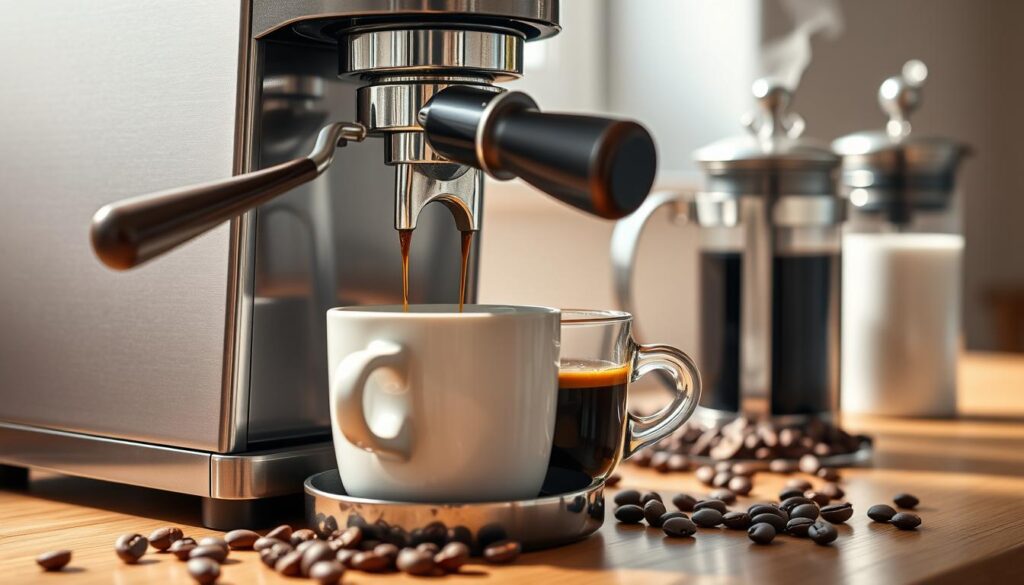Espresso brewing is an art that turns simple coffee beans into a rich, concentrated liquid. Mastering the perfect shot needs precision, skill, and a deep understanding of coffee extraction. Whether you’re a home barista or a coffee lover, making cafe-quality espresso is possible.
The path to an exceptional espresso starts with knowing its core principles. Professional coffee preparation is not just about fancy equipment. It’s about technique, passion, and detail. Every step in brewing, from bean selection to extraction, affects the final taste.
This guide will cover every step of espresso making, breaking down complex techniques into simple steps. You’ll learn to turn ordinary coffee beans into amazing shots that match professional coffee shops.
Key Takeaways
- Espresso is a concentrated coffee brewing method requiring precision
- Quality beans and proper extraction are crucial for great espresso
- Technique matters more than expensive equipment
- Understanding coffee extraction principles is fundamental
- Consistent practice leads to perfect espresso shots
Understanding Espresso Basics: From Bean to Brew
Espresso is a unique, concentrated coffee experience. It’s different from regular coffee, even though they both come from coffee beans. The way they’re made changes everything.
To get into espresso, you need to know its special traits and the science behind brewing it.
What Makes Espresso Different from Regular Coffee
Espresso and coffee differ in three main ways:
- Pressure extraction method
- Concentration of flavor
- Serving size and preparation
The Science Behind Pressure and Extraction
Pressure extraction is what makes espresso special. Unlike drip coffee, espresso uses 9-10 bars of pressure. This forces hot water through finely-ground coffee beans in about 25-30 seconds.
“Espresso is not just a drink, it’s a precise scientific art form.” – Coffee Experts
Key Components of Espresso Making
Several key parts are needed for great espresso:
| Component | Role in Espresso |
|---|---|
| Coffee Beans | High-quality, dark roast beans |
| Grind Size | Fine, consistent powder-like texture |
| Water Temperature | 195-205°F (90-96°C) |
| Pressure | 9-10 bars of consistent pressure |
Knowing these components turns a simple coffee drink into a unique experience.
Choosing the Right Espresso Beans and Roast Profiles
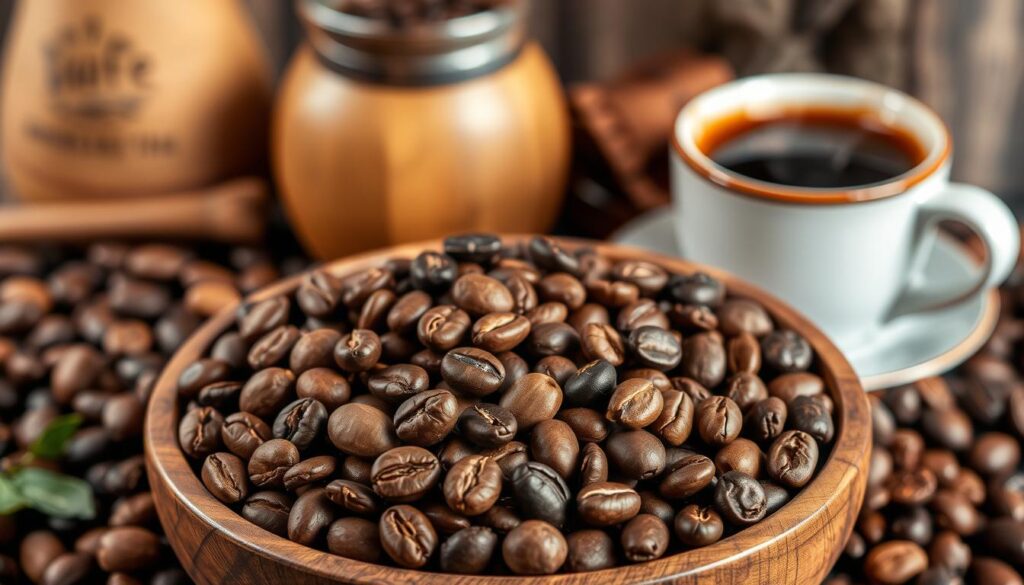
Finding the perfect espresso beans is an art. It turns a simple coffee drink into a special experience. This journey starts with knowing about bean selection and roast profiles.
“Great espresso starts with exceptional beans” – Coffee Artisan Wisdom
When looking at espresso beans, keep these points in mind:
- Origin of the beans (single-origin vs. blends)
- Flavor complexity and characteristics
- Roast level intensity
- Freshness and processing method
Coffee roast profiles are key to the espresso’s taste. Different roasting methods bring out unique flavors. These define your espresso’s personality.
| Roast Level | Flavor Profile | Espresso Characteristics |
|---|---|---|
| Light Roast | Bright, Acidic | Delicate, Floral Notes |
| Medium Roast | Balanced, Sweet | Smooth, Nuanced Flavor |
| Dark Roast | Bold, Intense | Rich, Chocolatey Undertones |
Baristas suggest trying different beans to find your perfect espresso. The perfect espresso is a personal journey of taste and technique.
Essential Equipment for Perfect Espresso Making
Making great espresso takes more than just love for coffee. You need the right tools. Whether you’re a pro or just starting, the right espresso machines, grinders, and tools make all the difference.
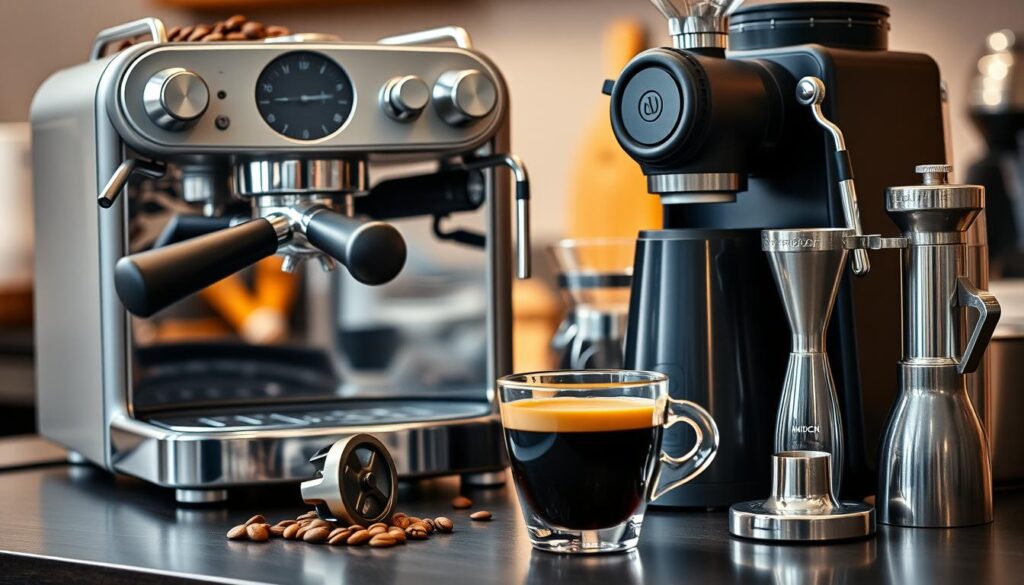
Starting your espresso journey means knowing the key equipment. It’s what takes your coffee from good to amazing.
Espresso Machine Selection
Choosing the right espresso machine is key for top-notch shots. There are many types for every skill level and budget:
- Manual lever machines for traditional brewing
- Semi-automatic machines for home enthusiasts
- Fully automatic machines for convenience
- Commercial-grade machines for serious coffee lovers
Grinder Fundamentals
Coffee grinders are the heart of espresso making. A good grinder gives you the right grind size. This affects how well the coffee extracts and tastes.
| Grinder Type | Pros | Cons |
|---|---|---|
| Blade Grinders | Affordable, compact | Inconsistent grind size |
| Burr Grinders | Precise, uniform grind | Higher cost |
Essential Barista Tools
There are more tools than just machines and grinders that make espresso better:
- Precision tamper
- Distribution tool
- Milk frothing pitcher
- Digital scale
- Cleaning brushes
“The right equipment turns coffee brewing from a task into an art form.” – Professional Barista
Choosing the best espresso machines, knowing about grinders, and getting reliable barista tools are key. They help you make amazing espresso at home.
The Art of Grinding: Achieving the Perfect Consistency
Mastering coffee grinding techniques is key to making great espresso. The grind size is crucial for extracting the best flavors. Precision is essential in preparing the espresso grind.
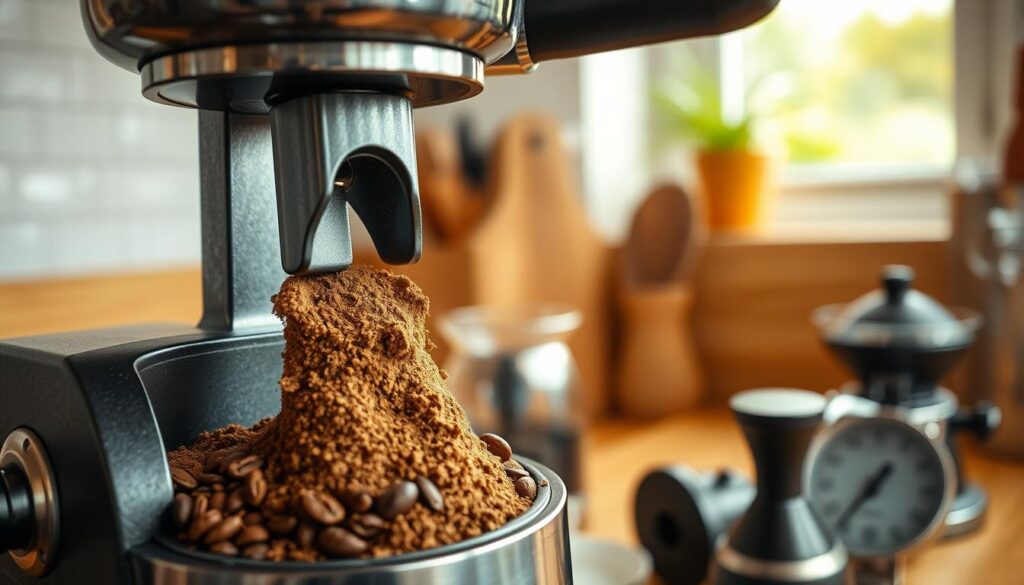
- Particle uniformity impacts extraction quality
- Grind size directly influences flavor intensity
- Consistency prevents uneven extraction
“The difference between good and great espresso often lies in the grind.” – Professional Barista
Different espresso grinds need specific approaches. Fine, consistent grinds are vital for perfect extraction. Baristas recommend using burr grinders for the best precision.
| Grind Type | Extraction Time | Flavor Profile |
|---|---|---|
| Extra Fine | 20-25 seconds | Intense, Rich |
| Fine | 25-30 seconds | Balanced, Smooth |
| Medium Fine | 30-35 seconds | Mild, Subtle |
Investing in a high-quality grinder changes your espresso game. Consistent grind size means every shot is full of flavor and crema. Your home brewing becomes as good as a pro’s.
Espresso 101: How to Pull the Perfect Shot
Making the perfect espresso shot is an art that needs precision and practice. It starts with knowing how to extract, tamp, and time your shot.
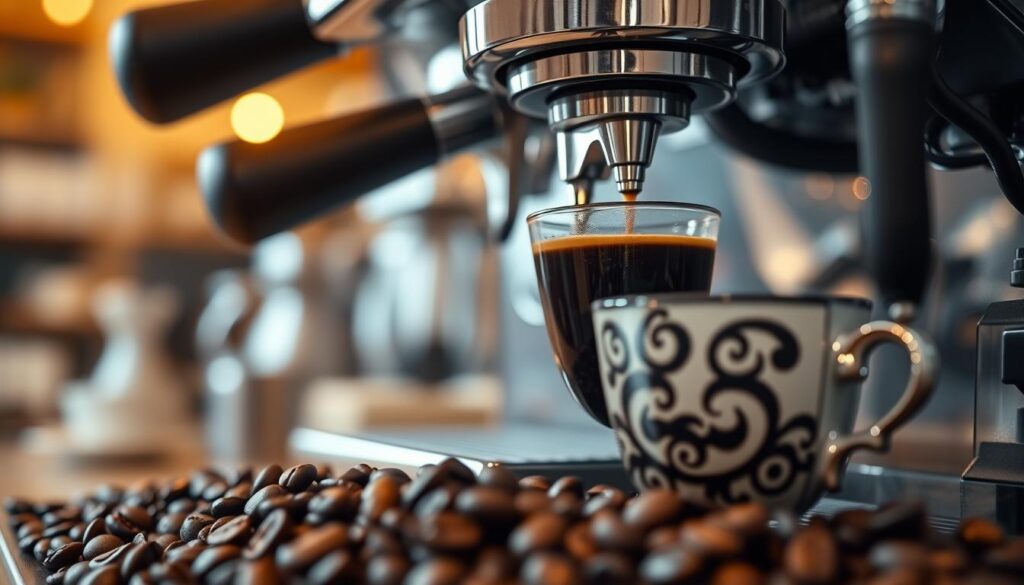
To pull an amazing espresso shot, you must focus on several key elements. These elements work together to make a rich and flavorful espresso.
Dosing and Distribution Techniques
Good espresso starts with the right amount and even distribution of coffee grounds. Baristas follow these steps:
- Measure 18-20 grams of freshly ground coffee
- Use a distribution tool to create an even coffee bed
- Eliminate air pockets and ensure uniform density
Mastering Tamping Pressure
The tamping technique is key to espresso quality. It ensures even extraction and prevents channeling.
| Tamping Technique | Recommended Approach |
|---|---|
| Pressure | 30-40 pounds of consistent pressure |
| Angle | 90-degree vertical position |
| Motion | Single, smooth press with no twisting |
Shot Timing and Visual Indicators
Timing is everything in espresso extraction. A perfect shot takes 25-30 seconds. Look for these visual cues:
- Initial dark brown stream
- Gradual lightening to honey color
- Final light blonde stream
“The difference between good and great espresso lies in the details of extraction.” – Professional Barista Wisdom
By paying attention to dosing, tamping, and timing, you can make your espresso extraction amazing.
Temperature and Pressure: Critical Variables
Making the perfect espresso shot needs a good grasp of two key factors: brewing temperature and espresso pressure. These elements greatly affect the taste, smell, and quality of your espresso.
Espresso pressure is crucial for pulling out the coffee’s rich flavors. The best pressure is between 9 and 10 bars. This creates the crema and intense flavor that espresso fans love.
“Precision in brewing temperature can make or break your espresso experience.”
- Brewing temperature usually falls between 195°F and 205°F
- Temperature affects how fast flavors are extracted and how complex they are
- Keeping the temperature steady ensures your espresso shots are balanced
Getting the hang of extraction variables means paying close attention to both temperature and pressure. Even small changes can greatly change how your espresso tastes.
| Variable | Ideal Range | Impact on Espresso |
|---|---|---|
| Brewing Temperature | 195-205°F | Flavor extraction and balance |
| Espresso Pressure | 9-10 bars | Crema formation and intensity |
Professional baristas know that mastering these extraction variables is key to producing exceptional espresso consistently.
Troubleshooting Common Espresso Problems
Making the perfect espresso needs precision and knowing how to solve brewing challenges. It’s key for coffee lovers who want great shots every time.
Understanding Extraction Dynamics
Extraction problems can really affect your espresso’s taste. Two big issues are under-extraction and over-extraction.
- Under-extraction makes espresso weak and sour.
- Over-extraction makes it bitter and harsh.
Diagnosing Coffee Channeling
Coffee channeling is a big problem where water flows unevenly through the coffee. It messes up even extraction and lowers shot quality.
Solving Extraction Challenges
| Problem | Potential Cause | Solution |
|---|---|---|
| Uneven Extraction | Inconsistent Grind | Invest in High-Quality Burr Grinder |
| Channeling | Poor Tamping | Use Consistent Tamping Pressure |
| Weak Shots | Incorrect Grind Size | Adjust Grinder Settings |
“Precision in espresso making is an art form that requires continuous learning and adjustment.” – Professional Barista
Getting good at fixing espresso problems means knowing your gear, practicing, and tweaking to get the perfect shot.
Mastering Milk Steaming and Microfoam
Milk steaming is key for making top-notch espresso drinks. Turning milk into smooth microfoam makes a simple espresso into a fancy treat.
Baristas know that making perfect microfoam takes skill and patience. It’s not just about warming milk. It’s about making it silky to boost the espresso’s taste and look.
- Start with cold, fresh milk
- Use a clean, cold pitcher
- Position the steam wand at a 45-degree angle
- Listen for a subtle chirping sound during steaming
Latte art is all about mastering microfoam. The trick is to keep the right temperature and get a smooth, paint-like foam. This lets you create cool designs.
“Great milk steaming is the difference between a good and extraordinary espresso drink.” – Professional Barista
| Milk Type | Optimal Steaming Temperature | Foam Quality |
|---|---|---|
| Whole Milk | 140-155°F | Richest microfoam |
| Skim Milk | 135-145°F | Lighter, less stable foam |
| Oat Milk | 130-140°F | Moderate foam stability |
Practice is the ultimate key to developing exceptional milk steaming skills. Try different milks, steam wand methods, and pitcher moves to get pro-quality microfoam.
Daily Maintenance and Cleaning Routines
Keeping your espresso machine in top shape is key to great coffee. Regular cleaning keeps your machine running well and your coffee tasting perfect. It also makes your machine last longer.
Machine Cleaning Protocols
Good care for your machine includes several important steps:
- Daily wipe-down of external surfaces
- Backflushing the group head with specialized cleaning solution
- Cleaning portafilter and basket thoroughly after each use
- Descaling the machine every 3-6 months
Preventive Maintenance Tips
To keep your espresso machine in top condition, try these tips:
- Use filtered water to reduce mineral buildup
- Replace water filters regularly
- Check gaskets and seals for wear and tear
- Lubricate moving parts as recommended by manufacturer
“A well-maintained espresso machine is the secret to consistently exceptional coffee.” – Professional Barista
When to Seek Professional Service
Some tasks need a pro. Schedule professional servicing if you see:
- Unusual noises during operation
- Inconsistent water pressure
- Significant drop in coffee quality
- Visible mechanical damage
Regular upkeep stops expensive fixes and keeps your espresso machine making perfect shots for years.
Conclusion
Learning to make great espresso is a journey that takes time and love. It starts with basic skills and grows with practice. Every shot you make is a chance to get better and enjoy coffee more.
Being a skilled home barista takes time and effort. You learn by trying new things and paying attention to details. Knowing how to pick beans, grind them right, and use your equipment well makes your coffee special.
True espresso mastery is about being precise and creative. Whether you’re new or have been doing it for a while, the journey is always exciting. Keep exploring and enjoy the world of specialty coffee.
Working hard to improve your barista skills will make your espresso better. Enjoy the journey, celebrate your wins, and keep learning with excitement.
FAQ
What’s the difference between espresso and regular coffee?
Espresso is made by forcing hot water through finely-ground coffee beans under high pressure. This creates a strong, rich shot with a creamy top. Unlike drip coffee, espresso is more concentrated and has more caffeine per ounce.
How important is the grind size for making espresso?
Grind size is key for espresso. The coffee should be ground very fine, almost like powder. This allows for proper water pressure and extraction. A consistent fine grind ensures even extraction and perfect flavor balance.
What type of espresso machine is best for beginners?
Beginners should start with a semi-automatic espresso machine. These machines offer a mix of automation and manual control. They help new baristas learn while managing temperature and pressure.
How much does a good home espresso setup cost?
A good home espresso setup can cost between 0 and ,000. Entry-level setups start at 0, while top-of-the-line equipment can be several thousand dollars.
What’s the ideal water temperature for brewing espresso?
The best water temperature for espresso is between 195°F and 205°F. This range ensures flavors are extracted properly without bitterness.
How long should an espresso shot take to pull?
An espresso shot should take 25 to 30 seconds to pull. This time ensures the right flavor balance and quality.
How often should I clean my espresso machine?
Clean your espresso machine daily and deep clean weekly. This includes backflushing, cleaning portafilters, and descaling. It keeps the machine working well and your espresso tasting great.
Can I make espresso without an espresso machine?
Yes, you can make espresso-like coffee with a Moka pot or AeroPress. But, these methods can’t match the high pressure of a true espresso machine. The flavor and texture will be different.
What’s the best way to store espresso beans?
Store espresso beans in an opaque, airtight container away from light, heat, and moisture. Keep them at room temperature and use within 2-4 weeks of roasting. Avoid refrigeration or freezing, as it can harm the beans.
How do I know if my espresso shot is well-extracted?
A well-extracted espresso has a rich, golden-brown crema and balanced flavor. It should flow smoothly and have a complex taste. Avoid bitterness or sourness for the best shot.
Share this post: on Twitter on Facebook

